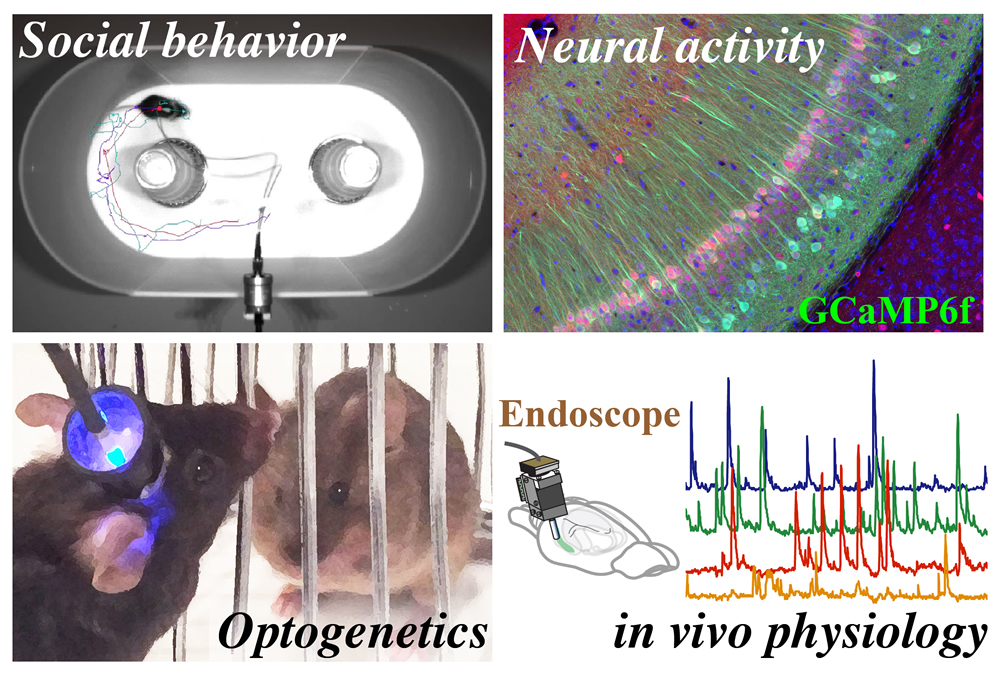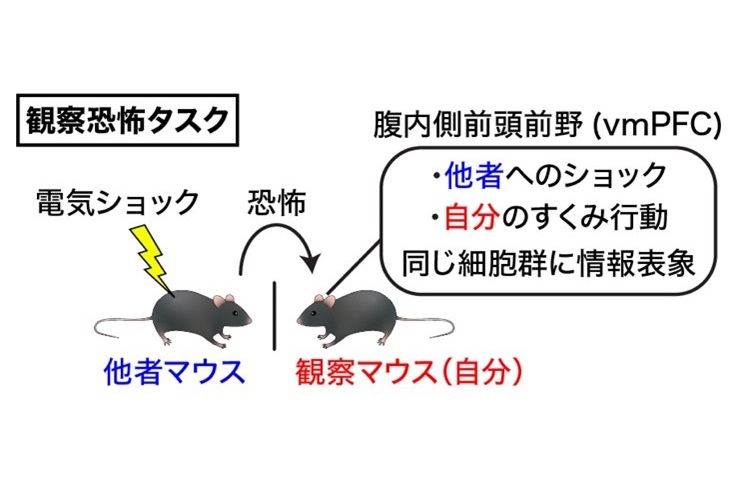Theme
Revealing neural mechanisms underlying various social behaviors by optogenetics and physiological methods, from the viewpoint of social memory engram in the hippocampus.
About Research
Optogenetic analysis of neural circuits for social behavior.
For animals who form a society, it is crucial to remember and recognize different conspecific individuals (i.e. having “social memory”), and exhibit appropriate social behavior towards each other. Using optogenetic techniques, we demonstrated that ventral CA1 (vCA1) pyramidal neurons in the hippocampus store social memory (social memory engram). Even if the memory seemed lost after long separation periods, optogenetic activation of the engram can fully restore that social memory. Additionally, artificial association between social engram encoding the memory of a specific individual with fear or reward events can elicit avoidance.
On the other hand, one tiny dissonance in social memory can easily disrupt the appropriate social behavior, even in humans. Social impairments caused by genetic mutation, especially those related to familiarization with other individuals, are commonly exhibited by patients diagnosed with autism spectrum disorder. Autistic patients have difficulty either with social memory itself, or showing typical behavior of social familiarity driven by social memory. We attempt to reveal the mysterious underpinnings of social memory in autism, while aiming at the ultimate goal of our lab — the improvement of autism treatment.
Publication
- Ventral CA1 neurons store social memory.
Okuyama T, Kitamura T, Roy DS, Itohara S, Tonegawa S.
Science. 2016 Sep 30;353(6307):1536-1541.
- Sexual representation of social memory in the ventral CA1 neurons.
Watarai A, Tao K, Okuyama T.
bioRxiv. 2024. https://www.biorxiv.org/content/10.1101/2024.04.01.587523v1
- The ventral hippocampus and nucleus accumbens underlie long-term social memory about female conspecifics in male mice.
Watarai A, Ishida K, Okuyama T.
bioRxiv. 2024. https://www.biorxiv.org/content/10.1101/2024.01.08.574751v1
- Conditional knockout of Shank3 in the ventral CA1 by quantitative in vivo genome-editing impairs social memory in mice.
Chung M, Imanaka K, Huang Z, Watarai A, Wang M, Tao K, Ejima H, Aida T, Feng G, Okuyama T.
Nature Communications. 2024 in press
- Ventromedial prefrontal neurons represent self-states shaped by vicarious fear in male mice.
Huang Z, Chung M, Tao K, Watarai A, Wang M, Ito H, Okuyama T.
Nature communications. 2023 Jul 3;14(1):3458.
- Disrupted social memory ensembles in the ventral hippocampus underlie social amnesia in autism-associated Shank3 mutant mice.
Tao K, Chung M, Watarai A, Huang Z, Wang M, Okuyama T.
Molecular psychiatry. 2022 Apr;27(4):2095-2105.
- Locus coeruleus input to hippocampal CA3 drives single-trial learning of a novel context.
Wagatsuma A, Okuyama T, Sun C, Smith L, Abe K, Tonegawa S.
Proceedings of the National Academy of Sciences. 2018 Jan 9;115(2):E310-E316
- Distinct Neural Circuits for the Formation and Retrieval of Episodic Memories.
Roy DS, Kitamura T, Okuyama T, Ogawa SK, Sun C, Obata Y, et al.
Cell. 2017 Aug 24;170(5):1000-1012.e19.
- Engrams and circuits crucial for systems consolidation of a memory.
Kitamura T, Ogawa SK, Roy DS, Okuyama T, Morrissey MD, Smith LM, et al.
Science. 2017 Apr 7;356(6333):73-78.
- Social memory engram in the hippocampus.
Okuyama T.
Neuroscience Research. 2017 Jun 1. pii: S0168-0102(17)30186-4.
Teruhiro Okuyama
Professor
Ph.D.
Graduate School of Medicine,Graduate School of Science
Kentaro Tao
Research Associate
Ph.D.
Akiyuki Watarai
Project Research Associate
Ph. D.









